Welcome to Valhalla: Inside the New 250GB Xbox 360 Slim
by Anand Lal Shimpi on June 18, 2010 1:59 AM ESTI own a total of five Xbox 360s. Four of them have died. Three because of the Red Ring of Death, all out of warranty. Many have had serial Xbox 360 failures, I had them in parallel.
The last revision of the Xbox 360, codenamed Jasper, was supposed to fix the infamous RRoD problem. So far my Jasper has been running fine. While Microsoft never confirmed the cause the RRoD seemed to be a result of poor cooling and manufacturing issues (either at the die/underfill level or at the solder level or both).
Needless to say, I wasn’t terribly happy about purchasing a sixth Xbox 360, but here it is:
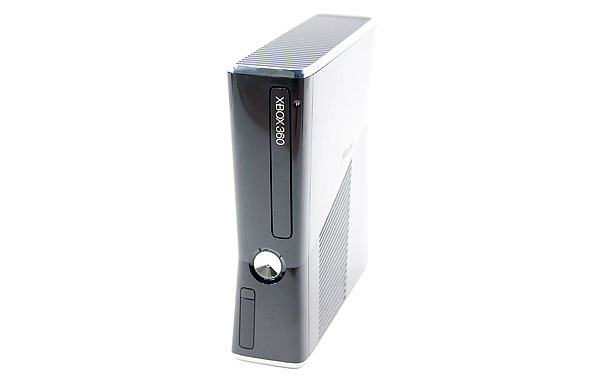
This is the latest revision of the Xbox 360, commonly referred to as the Xbox 360 Slim thanks to its shrinking in virtually all dimensions compared to the previous white box:
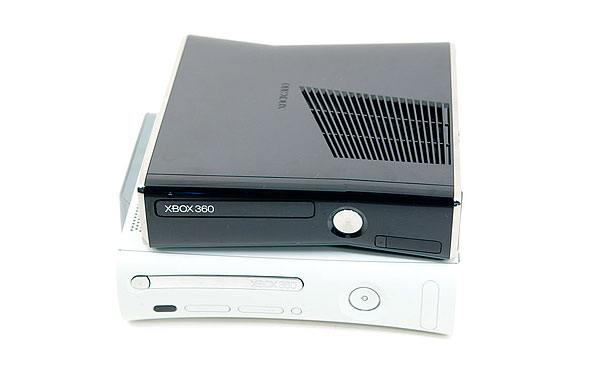

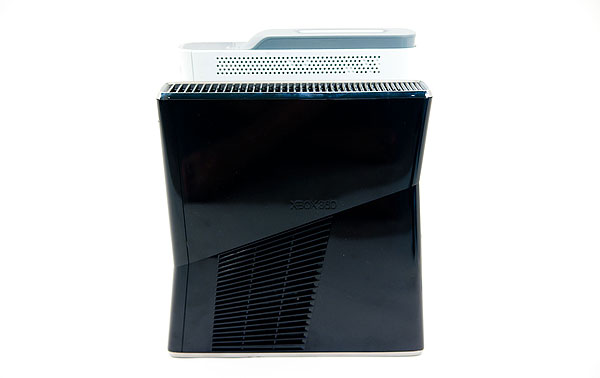
The internals are mostly new, featuring for the first time a single chip with CPU, GPU and eDRAM. Prior to this motherboard revision the Xbox 360 motherboard had two discrete packages, one with the CPU and one with the GPU + eDRAM.
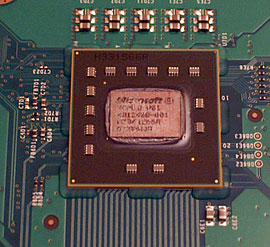 |
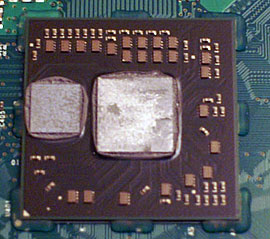 |
For those of you who don't remember, ATI originally designed the Xbox 360's GPU and called it Xenos. The GPU was the first we ever looked at that used a unified shading architecture, so there were no dedicated pixel or vertex units. The core was made up of 48 shader processors and each SP could work on a vect4 plus a scalar op in parallel. These days we'd probably call it a GPU with 240 cores, although it's a bit dated from a functionality standpoint. The GPU runs at 500MHz and is also home to the memory controller.

On a separate die, which ATI referred to as the daughter die, was 10MB of embedded DRAM along with all of the hardware necessary for z and stencil operations, color and alpha processing and AA. This eDRAM and associated logic helped Microsoft bring AA to games and improve overall performance compared to what was possible at the time with conventional architectures.
The CPU, codenamed Xenon, implemented three in-order PowerPC cores with SMT support - meaning the whole chip could work on six threads at the same time. The design was ahead of its time but given its 90nm manufacturing process it only had 1MB of L2 cache to share among all three cores. These days it isn't really considered the ideal approach to a many-core CPU. Private L2 caches with a large shared L3 cache is preferred for scaling beyond two cores.
Leading up to Jasper, each die was shrunk independently with each Xbox iteration. The table below shows us how:
| Xbox 360 Revision | CPU | GPU | eDRAM |
| Xenon/Zephyr | 90nm | 90nm | 90nm |
| Falcon/Opus | 65nm | 80nm | 80nm |
| Jasper | 65nm | 65nm | 80nm |
With the new Xbox 360 (codenamed Valhalla), at least two, possibly all three of the die are combined and placed on a single package:

Bringing it all onto (presumably) a single die makes cooling much simpler as now there’s only one heatsink and one fan for all of the major heat generating components in the unit. This level of integration is made possible only by the not-so-magic of Moore’s Law. At 40nm it shouldn’t be a problem to bring all of those components onto a single reasonably sized die, which in turn reduces Microsoft’s manufacturing costs. It’s not totally clear whether Microsoft is building these chips on a 40nm, 45nm or 55nm node. The 40nm approach would make the most sense but TSMC is very capacity constrained at this point so it would be a slow ramp before all Xboxes got the Valhalla treatment. Update: Apparently 45nm is the magic number. The new CGPU is rumored to be made at Chartered Semiconductor, now under the ownership of Global Foundries.
The uncertainty is because of a pesky heat spreader. While previous Xbox 360 CPU/GPUs were visible to the naked eye once you popped the heatsink off, the Valhalla design has a heat spreader covering the Xbox CGPU (Microsoft’s term, not mine). Unwilling to potentially kill yet another Xbox 360, I’ve left my heat spreader intact for the purposes of this article.
What follows is an entire dissection guide for those of you who want to get inside the new Xbox 360 (for whatever reason you might have ;), as well as some power/noise information for those of you contemplating the upgrade.
Enjoy.










109 Comments
View All Comments
Huggy_Bear - Friday, June 18, 2010 - link
I cannot believe nobody has talked about this yet!?Blu-ray drive anyone?
Is the DVD drive plain old SATA/standard form factor? In which case one could theoretically replace it w/ an off-the-shelf SATA blu-ray drive?? Now, OS support and blu-ray playback might be the main issue here...
tipoo - Sunday, June 20, 2010 - link
You answered your own question there, even if it uses standard connecters the OS probably would not recognize the new drive.Gamerguy1020 - Friday, June 18, 2010 - link
Does anyone know if this new 360 has gigabit ethernet, as opposed to the 10/100 on older xboxes?Finally - Friday, June 18, 2010 - link
If Valhalla is the place where Vikings get to when they die,does that mean that this new XBOX will die once it gets to you?
Finally - Friday, June 18, 2010 - link
Or does it mean that this new XBOX represents Valhalla and YOU have to die to get one?Finally - Friday, June 18, 2010 - link
As it seems, all of the above is inccorect as only certain body parts of yours have to die in order for Valhalla to enter your house:If I had to imagine a picture that shows over-exaggerated self pity plus stupidity all at once I would make a video with some fat nerd uttering this statement. Seriously...
Ninjahedge - Friday, June 18, 2010 - link
It is nice to have a smaller form factor, but being one of those people that actually has the money for a stereo w/surround and optical input attached to my HDTV, it would be nice if they considered ME in their form factor.I HAVE an AV cabinet! I would LIKE a box to be a nicely sized component I can stack in there, complete with internal BR and PS. It could even be slightly LARGER than that original (the horizontal footprint would have to be) so long as I had something that would look like a wicked system component capable of/posessing:
Gaming (duh)
Internet Access (limited) and Video
Net/Internet Streaming and Custom Codec installation
Blue Ray/DVD playback
Unlimited USB connectivity
Limited video RECORDING (C'mahn! TiVo should not be the only one!)
Front LED display
I would like a combo Gamer/Vid/Media center. They could get away with charging slightly more for something that would only cost $400 but take the place of an UNLICENSED HTPC + Proprietary gaming system.
But no. We all know adults do not play games.
jeremyshaw - Friday, June 18, 2010 - link
Just a note, it's also likely MS used Global Foundries (since they bought off Chartered, the IBM Xenon CPU fab location MS chose), if the CPU and GPU have indeed been unified into a monolithic IC.ajlueke - Friday, June 18, 2010 - link
With what is shown here, I would consider getting one of these to replace the Xenon based 360 I purchased in December of '05. Yes, I purchased and original run 360 and it has not to this day RRoD on me.However, it still has only the 20Gb HDD and a lack of HDMI, as well as the external 802.11g wireless adapter a purchased years ago. Not to mention over twice the power consumption of the new model. May be time to upgrade.
Krakn3Dfx - Friday, June 18, 2010 - link
"some exciting titles due out later this year and next"Besides Halo Reach, Gears 3, and an unnamed Crytek exclusive, their E3 showing seemed to be a lot of Kinect casual stuff. If I didn't know better, I would say Microsoft is dialing down on hardcore exclusive titles in favor of multiplat titles and banking a lot of their money on Kinect's ability to take a significant portion of the Wii's marketshare.